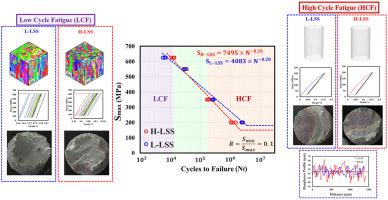Additive Manufacturing ( IF 10.3 ) Pub Date : 2020-12-25 , DOI: 10.1016/j.addma.2020.101805 Reza Esmaeilizadeh , Ali Keshavarzkermani , Usman Ali , Behzad Behravesh , Ali Bonakdar , Hamid Jahed , Ehsan Toyserkani

|
The mechanical performance of parts, made by laser powder-bed fusion (LPBF), under quasi-static and cyclic loadings can be altered significantly by changing the process parameters. To better understand the related changes, tensile and fatigue LPBF Hastelloy X coupons were manufactured at high and low laser scanning speeds (LSS) in the nearly full-dense processing window. The experimental results demonstrate that, although the microstructure and surface roughness of the parts varies by altering the LSS, the porosity or density of the printed samples are not changing significantly within the range studied here. High LSS samples show higher tensile strength and higher rates for strain hardening at the primary stages of the deformation. Statistical analysis of variance indicates that LSS is a significant factor affecting the fatigue life. The S-N diagram shows Basquin lines intersection at the midlife fatigue region. In the low cycle fatigue (LCF) region high LSS samples show higher cycles to failures due to hysteresis stabilization at lower strains and hence less relative pre-strain and cyclic damage. Since stress risers are important features at high cycle fatigue (HCF) due to stress concentration and associated plasticity, the low LSS samples tolerate a greater number of cycles at lower stress levels and show a higher fatigue limit obtained by the step-loading method. These findings suggest that the process parameters can be optimized to achieve the best possible performance based on the desired application in LCF or HCF for AM parts.
中文翻译:

激光粉末床熔合工艺参数对哈氏合金X准静态和疲劳行为的影响:微观结构/缺陷相互作用研究
通过改变工艺参数,可以显着改变在准静态和周期性载荷下由激光粉末床熔合(LPBF)制成的零件的机械性能。为了更好地了解相关变化,在接近全密实的加工窗口中以高激光扫描速度和低激光扫描速度(LSS)制造了拉伸和疲劳LPBF Hastelloy X试样。实验结果表明,尽管零件的微观结构和表面粗糙度会因LSS的改变而变化,但在此处研究的范围内,印刷样品的孔隙率或密度没有明显变化。高LSS样品在变形的主要阶段显示出较高的拉伸强度和较高的应变硬化速率。方差的统计分析表明,LSS是影响疲劳寿命的重要因素。SN图显示在中年疲劳区的Basquin线相交。在低周疲劳(LCF)区域中,高LSS样品由于在较低应变下的磁滞稳定而显示出较高的失效循环,因此相对的预应变和循环损伤也较小。由于应力集中和相关的可塑性,应力升高是高循环疲劳(HCF)的重要特征,因此低LSS样品在较低的应力水平下可承受更多的循环次数,并显示出通过逐步加载方法获得的较高的疲劳极限。这些发现表明,基于在AM组件的LCF或HCF中的所需应用,可以优化过程参数以实现最佳性能。在低周疲劳(LCF)区域中,高LSS样品由于在较低应变下的磁滞稳定而显示出较高的失效循环,因此相对的预应变和循环损伤也较小。由于应力集中和相关的可塑性,应力升高是高循环疲劳(HCF)的重要特征,因此低LSS样品在较低的应力水平下可承受更多的循环次数,并显示出通过逐步加载方法获得的较高的疲劳极限。这些发现表明,基于在AM组件的LCF或HCF中的所需应用,可以优化过程参数以实现最佳性能。在低周疲劳(LCF)区域中,高LSS样品由于在较低应变下的磁滞稳定而显示出较高的失效循环,因此相对的预应变和循环损伤也较小。由于应力集中和相关的可塑性,应力升高是高循环疲劳(HCF)的重要特征,因此低LSS样品在较低的应力水平下可承受更多的循环次数,并显示出通过逐步加载方法获得的较高的疲劳极限。这些发现表明,基于在AM组件的LCF或HCF中的所需应用,可以优化过程参数以实现最佳性能。由于应力集中和相关的可塑性,应力升高是高循环疲劳(HCF)的重要特征,因此低LSS样品在较低的应力水平下可承受更多的循环次数,并显示出通过逐步加载方法获得的较高的疲劳极限。这些发现表明,基于在AM组件的LCF或HCF中的所需应用,可以优化过程参数以实现最佳性能。由于应力集中和相关的可塑性,应力升高是高循环疲劳(HCF)的重要特征,因此低LSS样品在较低的应力水平下可承受更多的循环次数,并显示出通过逐步加载方法获得的较高的疲劳极限。这些发现表明,基于在AM组件的LCF或HCF中的所需应用,可以优化过程参数以实现最佳性能。











































 京公网安备 11010802027423号
京公网安备 11010802027423号